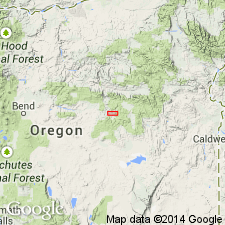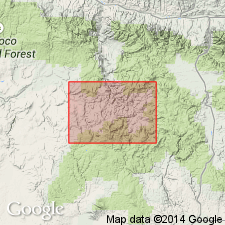
- Usage in publication:
-
- Buck Creek felsite tuff
- Modifications:
-
- Named
- Dominant lithology:
-
- Tuff
- AAPG geologic province:
-
- Blue Mountains province
Summary:
Quartz keratophyre occurring as thin stratigraphic unit is "designated informally here as Buck Creek felsite tuff". Buck Creek is in Grant Co, OR. Is lowermost of 4 clastic volcanic sequences in Trowbridge formation. Has been traced continuously for 12 mi along strike across South Fork from Sheep Creek on west to Lewis Creek on east. Shown on geologic sketch map of area near Izee, OR. Is 60 to 75 ft thick. Age of Trowbridge formation is "Callovian in its entirety (R.W. Imlay, personal communication)".
Source: GNU records (USGS DDS-6; Menlo GNULEX).

- Usage in publication:
-
- Buck Creek felsite tuff
- Modifications:
-
- Revised
- AAPG geologic province:
-
- Snake River basin
Summary:
Pg. 61. Basal resistant sequence in Officer Member (new) of Trowbridge Formation is ledge-forming felsite tuff unit informally named Buck Creek felsite tuff (Dickinson, 1962). Maintains thickness of 60 to 70 feet throughout area of Sheep Creek, but thins rapidly to feather edge to west.
Source: US geologic names lexicon (USGS Bull. 1350, p. 97).
For more information, please contact Nancy Stamm, Geologic Names Committee Secretary.
Asterisk (*) indicates published by U.S. Geological Survey authors.
"No current usage" (†) implies that a name has been abandoned or has fallen into disuse. Former usage and, if known, replacement name given in parentheses ( ).
Slash (/) indicates name conflicts with nomenclatural guidelines (CSN, 1933; ACSN, 1961, 1970; NACSN, 1983, 2005, 2021). May be explained within brackets ([ ]).

